Author: Biteye core contributor Viee
Karak, which was quick and emerged out of nowhere, took only about two months from announcing a financing with a valuation of 1 billion to launching an early access staking plan and now supporting various assets.
Where did Karak, regarded as a newcomer in restaking, come from? How much of a splash can it make in the restaking track? How to participate in Karak in the early stages of the project to get a higher probability of airdrops? In this research report, Biteye will take you to a deeper understanding of Karak Network.
01 Karak, which was born with a valuation of 1 billion
Karak Network is a restaking network. Similar to restaking projects such as Eigenlayer, it also uses a points model to incentivize users to restake and obtain multiple benefits.
In December 2023, Karak announced that it had received $48 million in Series A financing, led by Lightspeed Venture Partners, and participated by Mubadala Capital, Coinbase and other institutions. Mubadala Capital is the second largest fund in Abu Dhabi. In this round of financing, Karak is valued at more than $1 billion.
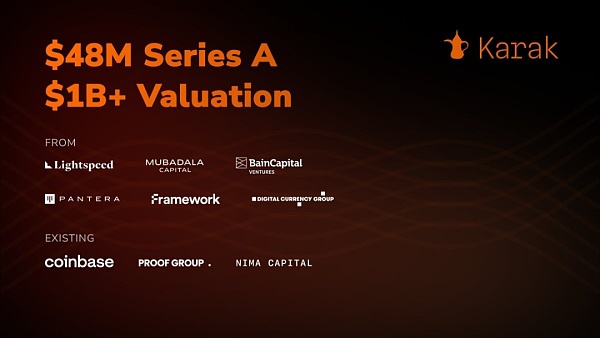
(Figure: Details of Karak Series A Financing)
In February 2024, Karak announced the launch of an early access program, allowing users to earn XP points by re-staking on Karak. In addition to receiving rewards from cooperative projects, they can also obtain Karak XP. XP is distributed through the protocol and may eventually be airdropped by converting points into tokens.
Private access was opened on April 8, 2024. As of April 12, the total TVL of different chains supported by Karak was US$140 million, of which Karak Network accounted for the highest proportion of 48.5%, Ethereum ranked second at 45.7%, and Arbitrum was 5.8%.
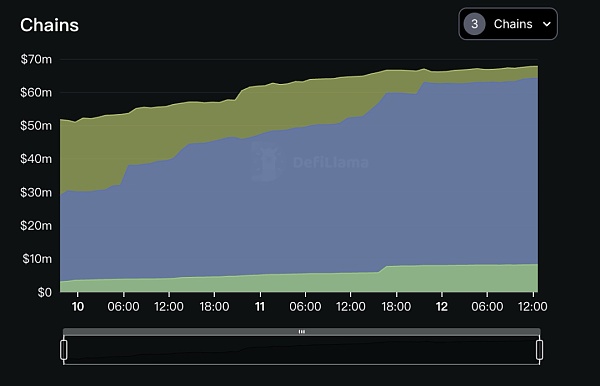
(Figure: TVL of Karak on different chains, https://defillama.com/protocol/karak#tvl-charts)
The emergence of Karak has attracted a lot of market attention. Although the total TVL is far less than that of EigenLayer, it has unique highlights on the technical level and may challenge EigenLayer's dominant position in the re-staking field.
02 Karak's technical path
2.1 Karak Network: A re-staking layer with the advantage of multi-chain support
Karak, as a re-staking platform, is different from EigenLayer, which focuses on Ethereum. Karak provides a diversified platform that supports multiple assets, including ETH, Solana, and various Layer2 tokens, enabling it to provide security solutions in multiple blockchain ecosystems, thus having higher diversity and inclusiveness. At present, Karak has supported Ethereum mainnet, Karak, Arbitrum and other networks.
Here is a simplified breakdown of how Karak works:
For validators, staked assets are assigned to Distributed Security Service Validators (DSS) on the Karak network and granted additional execution rights over their staked assets.
For developers, Karak allows for simple, non-dilutive incentives to attract validators. This significantly reduces costs compared to building a new trust network from scratch.
Karak acts as a bridge between developers and validators. Developers can attract validators by offering non-dilutive token incentives.
The reason is that Karak eliminates the mechanism by which new protocols must use highly dilutive rewards in order to attract and incentivize validators, which avoids issuing a large number of tokens in the early stages to ensure network security, preventing token value dilution and harming the interests of long-term holders. This setup significantly reduces costs and complexity.
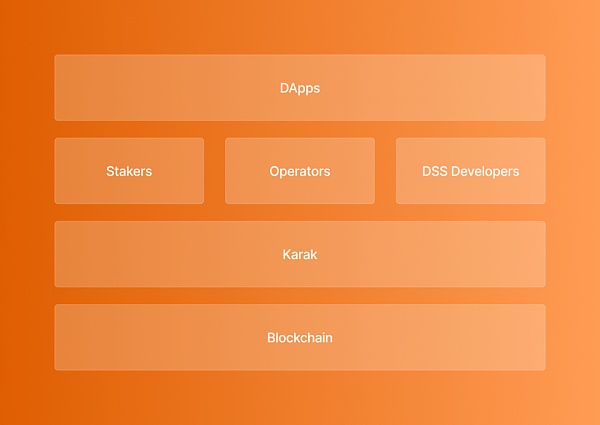
(Image source: https://docs.karak.network/karak)
Karak's technical path has three highlights:
1. Multiasset restaking: Karak introduces a multi-asset restaking function, which is a new security mechanism. Under this mechanism, users can re-stake various assets such as Ethereum, liquid pledge tokens, stablecoins, etc. to earn rewards. This multi-asset restaking not only increases the potential returns of users, but also greatly enhances the security of various Dapps, protocols, and DSS.
2. Restake anywhere: Karak internalizes a concept of universal restaking, making the secure restaking infrastructure accessible to anyone on any chain. This convenience allows developers to focus more on innovation and product development without having to spend a lot of time and resources on initial security measures.
3. Turnkey development environment: Karak allows new systems to access a strong and secure trust network from the beginning, which significantly reduces the threshold for new protocols to ensure their own security and allows these protocols to run without complex security settings.
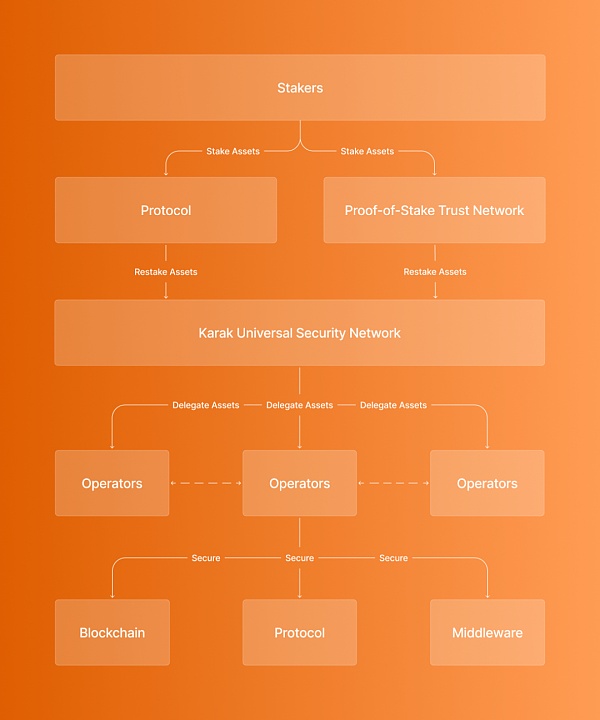
(Image source: https://docs.karak.network/karak)
In short, Karak's innovation not only provides users with the opportunity to re-stake multiple assets, but also greatly simplifies the security process of new protocols. These features together enhance Karak's competitiveness and attractiveness in the same track.
2.2 Comparison between Karak and EigenLayer
Karak, like EigenLayer, is a re-staking protocol, which means that it enables staked assets such as ETH to be re-staked by validators on multiple networks, while enabling validators to receive additional rewards. At first glance, Karak seems to be a "copycat" of Eigenlayer, but by comparing the technical paths of the two, some differences can be found.
So why is karak not a "copycat" of Eigenlayer, and what are the differences?
Reason 1: The dApp on Eigenlayer is called Active Verification Service (AVS), while the dApp on Karak is called Distributed Security Service (DSS). This will be explained in detail in the next section.
Reason 2: Eigenlayer's execution layer is on the Ethereum mainnet, but Karak has its own Layer2 (called K2) for sandbox testing, for DSS to develop and test before launching on Layer1.
Here we need to discuss the first question: What are AVS and DSS? What is the difference?
AVS stands for Actively Validated Services, a concept in the EigenLayer protocol. AVS can be simply likened to "middleware", providing services similar to data and verification capabilities for terminal products. For example, an oracle is not a terminal product, but it can provide data services for DeFi, wallets, etc., which is an AVS.
Understanding EigenLayer's AVS (active verification service) can be done through a simple and vivid metaphor:
Imagine Ethereum as a huge shopping mall, and various Rollup L2 (second layer solutions) are like stores in the shopping mall. To operate in a shopping mall, these stores need to pay rent, which is equivalent to paying GAS fees in the Ethereum world, so that their transactions and status data can be packaged and verified and stored in the ledger of the Ethereum "shopping mall".
In this metaphor, Ethereum not only provides the physical space (block space) of the store, but also takes responsibility for security (verifying the legitimacy and consistency of transactions) to ensure that all store transactions are safe and valid.
EigenLayer's AVS is like providing an affordable similar service for small vendors (projects) who want to set up stalls outside shopping malls. These small vendors themselves cannot or do not want to operate in shopping malls, such as mobile shops (need liquidity) and street shops (good geographical location), but these merchants also want to use some services of large shopping malls, so AVS can provide them with services. Although it may not be as comprehensive as the security inside the shopping mall, that is, it is reduced in consensus security and at the same time lower in cost. But this can provide a data or trust mechanism solution outside of Ethereum for dapps that cannot be verified in the Ethereum EVM network, so that even small-scale projects can find a foothold in the vast Ethereum ecosystem.
This approach is particularly suitable for application scenarios that do not require particularly high consensus security, such as some Dapp Rollups, cross-chain bridges, oracles, etc. These projects may not need the highest level of security provided by the Ethereum mainnet, so by choosing AVS, they can obtain the necessary security verification services at a lower cost while maintaining a relatively safe environment. The emergence of AVS is actually expanding the boundaries of the Ethereum ecosystem, allowing more diverse projects to join, especially those small projects with limited resources but innovative.
Similar to EigenLayer, Karak also has its own version of AVS, called Distributed Secure Services. Unlike EigenLayer, which is limited to the Ethereum ecosystem, Karak introduces a new concept - providing re-pledge services for multiple assets, supporting anyone to use any asset on any chain.
In an Ethereum-only environment, AVS needs to compete with every opportunity to provide Ethereum returns, and this competition is unsustainable without the expectation of airdrop speculation. DDS can absorb assets on more chains and use re-pledged assets to enhance security while reducing operating expenses. Compared to ETH, many assets have lower opportunity costs, which means that DSS has a simpler and more viable path to sustainable returns.
It is worth noting that the first AVS was launched on April 10th at the same time as the EigenLayer mainnet launch, and 6 AVS were released in succession. Karak plans to launch the first DSS in the coming weeks.
Next, let's discuss the second question: What is Karak's Layer2 K2? How is it different from Eigenlayer?
K2 is a Layer2 built on the Karak network.
Operating on Layer1 is relatively expensive for developers and users, so K2 provides a new solution. It acts as a "sandbox" environment, allowing distributed security services (DSS) to be developed and tested on k2 before they are officially deployed on L1 to ensure that they are stable and secure before actual application. In addition, by adding custom precompiles, allowing more validators to verify DSS, K2 not only improves efficiency and security, but also becomes more decentralized.
Compared to Eigenlayer, which uses the Ethereum mainnet as the execution layer, Karak has created its own execution layer (K2) and built on Layer2, which can provide faster transaction speeds and lower transaction costs without sacrificing security.
After understanding the above two questions, we can see that Karak and EigenLayer adopt differentiated technical paths, which also brings the most intuitive difference.
Karak supports more diverse assets besides ETH, and plans to cover Solana, Tia, Arbitrum, Optimism and other Layer2, aiming to create a cross-chain diversified re-staking layer. EigenLayer focuses on the Ethereum ecosystem and uses ETH as the main asset for re-staking, which is different from Karak's broader inclusiveness.
We can use an analogy to help understand, imagine Karak is like an international airport connecting multiple countries, welcoming passengers (assets) from all over the world, whether it is a large passenger plane (public chain assets such as Solana) or a small private plane (Layer2 assets such as Arbitrum). Karak's goal is to provide a convenient and safe transit station for these passengers. In contrast, EigenLayer is more like a subway system designed specifically for a metropolis (Ethereum ecosystem), focusing on serving residents and tourists in the city of Ethereum, and providing professional and efficient transportation services (transactions and operations).
That is to say, Karak, on a similar basis to EigenLayer, has expanded the range of re-pledged assets to include Ethereum, various liquid pledged Ethereum, and stablecoins, thereby expanding the range of user options.
It turns out that Karak's approach is effective. According to DefiLlama data, taking stablecoins as an example, stablecoins account for about 19% of Karak's re-pledged crypto assets, while stablecoins may be less than 0.27% of EigenLayer's re-pledged crypto assets. More differences can be seen from the following pie chart.
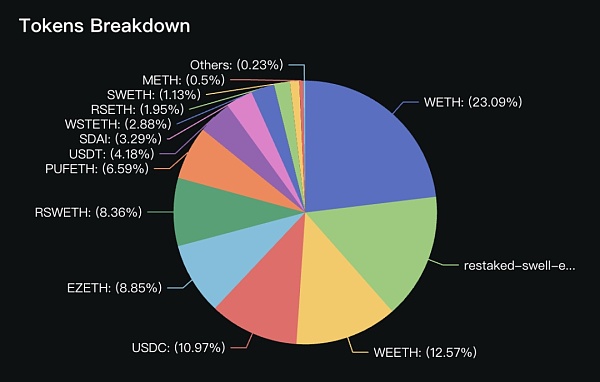
(Figure: Karak re-pledged encrypted assets details https://defillama.com/protocol/karak#tvl-charts)

(Figure: EigenLayer re-pledged encrypted assets details https://defillama.com/protocol/eigenlayer#tvl-charts)
03 Is Karak a vampire attack on Eigenlayer?
Looking back at SushiSwap's vampire attack on Uniswap, what would happen if Karak issued coins before Eigenlayer?
We must first understand what a "vampire attack" is. In the crypto field, a vampire attack is a strategy in which a project (in this case SushiSwap) tries to grab the user and liquidity share of another similar project (such as Uniswap) by offering better incentives (for example, higher liquidity provider LP rewards).
Simply put, a "vampire attack" is to "suck blood" by taking liquidity shares from the target object, thereby increasing its own liquidity and value.
In 2020, SushiSwap successfully attracted a lot of liquidity by forking Uniswap's code and introducing SUSHI as the native token of its platform. As similar protocols, Karak and Eigenlayer cannot rule out the possibility of "vampire attacks". If Karak issues coins first, we can speculate on the following possible situations:
1. Karak supports multiple assets and may attract potential re-staking users seeking asset diversity. If a vampire attack is performed, this will pose a challenge to EigenLayer.
2. Once Karak and Eigenlayer are running on the mainnet with multiple AVS/DSS, Karak may be able to perform a vampire attack and transfer the deposited Eigenlayer LRT assets from Eigenlayer to Karak. (Note: Karak allows re-staking of LRT that has been re-pledged on Eigenlayer. In fact, it allows LRT to be re-pledged, which is a bit like nesting dolls.)
If Karak issues coins first, it will indeed attract LRT in the entire market. More importantly, Karak's own chain is already available, and the speed and cost are acceptable. After all, one of Karak's outstanding advantages is that it has an execution layer, which determines that it is not Eigenlayer's younger brother, but an opponent.
04 How to become an early participant in Karak
Currently, the Karak project is still in a relatively early stage. You can get XP incentives by staking on the official website. In the future, Karak's airdrops will probably be carried out by converting points into tokens. The amount of XP earned may depend on how early or late you re-stake, how long you re-stake, and the number of new users who enter through the invitation code.
Enter the Karak official website staking interface
Official staking link:
https://app.karak.network/
Currently Karak supports staking networks: Ethereum mainnet, Arbitrum (L2), Karak (L2).
Karak supports staking assets: mETH and other LST assets, pufETH and other LRT assets, as well as USCT, USDC, sDAI three stablecoins. Please note that the tokens supported by different networks are different, please confirm carefully.
To put it simply, the points rule is that staking on Karak can get "staking rewards + re-staking rewards + Eigenlayer points + staked LRT points + Karak XP" at the same time.
Currently, Karak is not like Eigenlayer's "killing two birds with one stone". Instead, when Eigenlayer is already "saturated", it is possible to get higher returns by betting on other protocols, but there are both risks and returns.
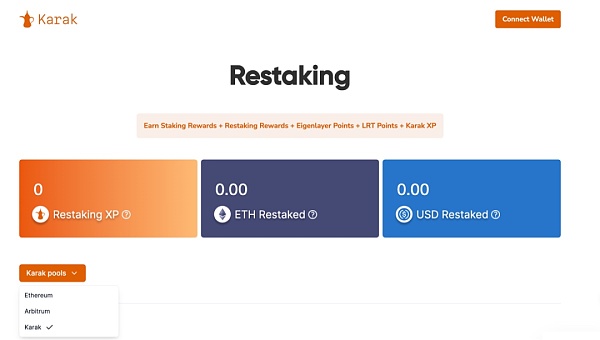
It is recommended that you stake directly on Karak (Karak's L2 network mentioned above) to get double Karak points. The specific steps are as follows.
First, add the Karak network
Enter Chainlist and select Karak Mainnet on the left
https://chainlist.org/?search=karak
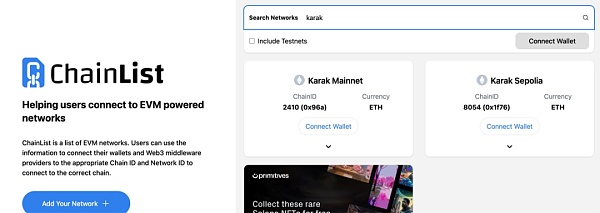
Then, cross the assets to the Karak chain. If you choose to pledge through the Karak chain, three tokens are currently supported: rswETH, USDC, wETH
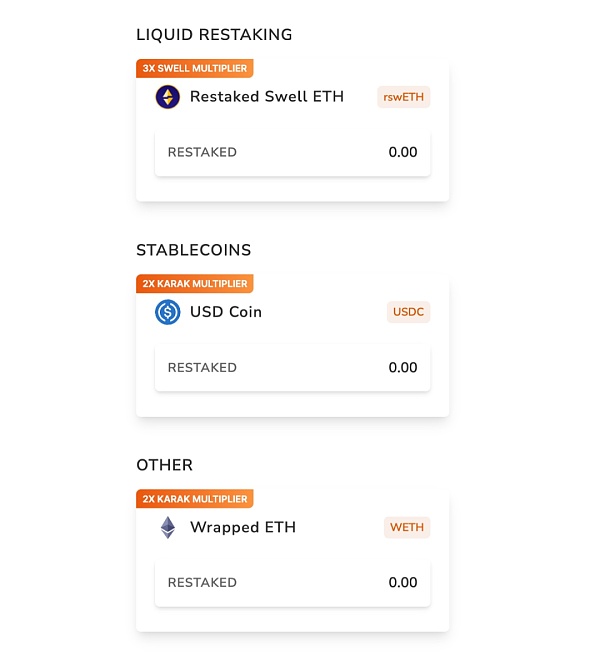
There are two situations for staking rswETH
1. If you have rswETH, you can cross to the Karak chain from the Karak official bridge.
2. If you don’t have rswETH, you can pledge eth in Swell to get rswETH (Swell can only pledge ETH on the main network, and you cannot transfer ETH to the Karak chain first and then pledge it), and then transfer it to the Karak chain through the Karak official bridge.
Swell pledge address:
https://app.swellnetwork.io/restake%EF%BC%89
There are also two situations for pledging wETH
1. If you have wETH, you can transfer it to the Karak chain from the Karak official bridge.
2. If you don’t have wETH, you can transfer ETH from the main network to Karak from the Karak official bridge or MiniBridge. Just turn on Auto-Wrap ETH when staking.
Karak official bridge and MiniBridge address:
https://karak.network/bridge
https://minibridge.chaineye.tools/?src=arbitrum&dst=karak
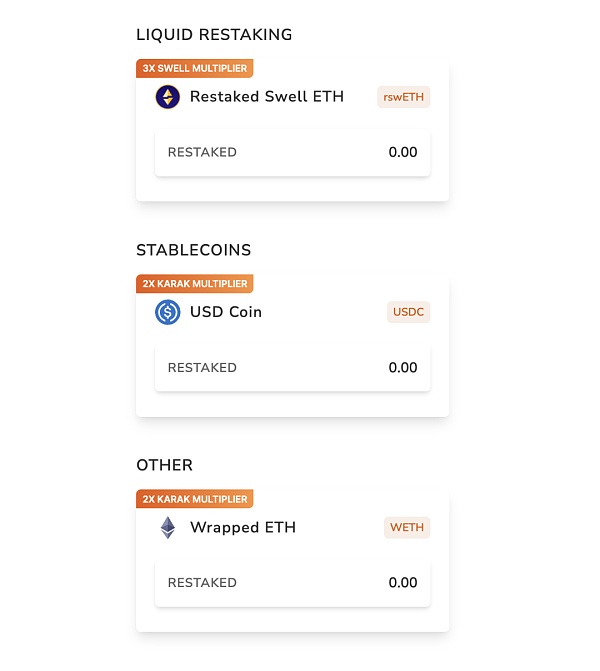
Finally, complete the pledge in Karak Pools.
Since the three supported tokens are not ETH, this means that cross-chain will require ETH as gas fee in the past. Especially for WETH, if you cross over ETH, after selecting max to deposit, the first step of the contract is a Deposit function, which is actually wrap ETH, which will cause the ETH in the wallet to be gone, resulting in the failure of the second step of deposit.
The recommended operations are as follows:
1. Pledge rswETH and USDC, and use the MiniBridge cross-chain tool to cross over a little more ETH as gas fee.
2. Pledge wETH, leave a little ETH, and don't click max. But if you accidentally stake all of max, it doesn't matter, you can use MiniBridge to cross over a little more ETH.
? MiniBridge supports ETH from the main network to the Karak chain, supports small cross-chain, and has low fees. It is used to pay the gas fee for staking on the Karak chain, welcome to click the link.
https://minibridge.chaineye.tools/?src=arbitrum&dst=karak
05 Risk Warning
Currently, the controversy surrounding Karak is mainly concentrated in two aspects.
First, after the team obtained financing at the end of 2023, it "hastily" launched the product in February of this year. As a re-staking project, there is currently less discussion around technology, and more marketing methods such as "points activities" are used to seize the market.
Second, the "self-protection behavior" of the Karak team's previous project was criticized by the community, and some KOLs even pointed out that it was RUG. In response to this question, the team responded in the DC on April 9.

In short, blockchain projects are always accompanied by contract risks and team risks, especially for re-pledge agreements that easily absorb hundreds of millions of dollars. However, from the current market environment, new users prefer projects with good investment institutions and huge financing backgrounds, while old users pay more attention to the past history of the project team.
06 Summary
How to balance risks and benefits has always been a concern for users.
As a newcomer in the re-staking track, Karak's 1 billion valuation and unique technical highlights have increased the possibility of challenging EigenLayer's dominance in the re-staking field. At the same time, Karak supports a variety of LRT token re-staking, including but not limited to Swell, Puffer, Renzo, EtherFi, KelpDAO, etc., which has also promoted the prosperity of the Ethereum staking ecosystem.
Perhaps sensing the "crisis", EigenLayer announced the cancellation of all deposit limits and reopening of the deposit window at 0:00 on April 17, Beijing time.
Should you choose EigenLayer in accordance with the rules, or bet on Karak for higher returns? This chess piece is in the hands of users at this moment.
 JinseFinance
JinseFinance














